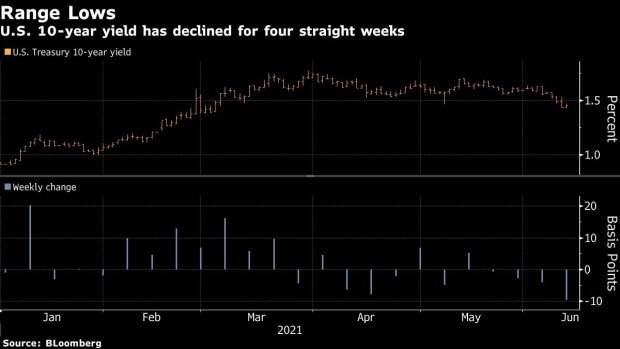Fancy Apartment Rentals for Paris Olympics See Poor Demand and Price Cuts
Locals who’d hoped to turn a big profit by renting out their posh apartments are now slashing prices by 30%-60%.
Latest Videos
The information you requested is not available at this time, please check back again soon.
Locals who’d hoped to turn a big profit by renting out their posh apartments are now slashing prices by 30%-60%.
The kingdom must overcome a conservative image and concern about human rights. Visit the desert oasis town of AlUla to understand the challenge.

Jury selection was completed Friday for Donald Trump’s first criminal trial, setting the stage for opening arguments Monday in a New York case accusing the former president of falsifying business records to conceal a sex scandal before the 2016 election.

Higher-than-expected interest rates amid persistent inflation are perceived as the biggest threat to financial stability among market participants and observers, according to the Federal Reserve.

Fifth Third Bancorp jumped the most in four months, leading bank stocks higher, with Chief Executive Officer Tim Spence predicting that income from lending has bottomed out.
Jun 12, 2021
, Bloomberg News

(Bloomberg) -- After the longest rally in almost a year, the Treasury market is ill-positioned for any surprises from the Federal Reserve next week.
Bond investors, who have been abandoning short bets, are anticipating that officials will reaffirm that their ultra-loose policy remains appropriate, and that it’s too soon to start even contemplating tapering the central bank’s purchases of Treasury and mortgage-backed securities.
Any hint that such discussions are in the works could provide a rude awakening after the 10-year yield touched the lowest level since March this week. The strength mystified traders; one, Mischler Financial Group’s Tony Farren, said the market appeared “bullet-proof.” Not only did the advance appear to be largely unprovoked, but it persisted in the face of hotter-than-forecast inflation data, hefty Treasury auctions and record highs for the S&P 500.
“My sense is there’s asymmetry” surrounding the possible market reaction to the Fed meeting, said Praveen Korapaty, head of U.S. interest-rate strategy at Goldman Sachs Group Inc.
The Fed is widely expected to keep its ultra-easy stance in its June 16 decision, and that’s Korapaty’s base-case too. Policy makers continue to insist that higher inflation reflects bottlenecks as the economy snaps back from the pandemic, and is unlikely to persist.
However, the minutes of the Federal Open Market Committee’s April meeting showed that some officials were open to a debate on trimming asset purchases at “upcoming meetings” if warranted.
For some investors, the case for tapering has been dented since then, in particular by weaker-than-expected labor-market data. So if officials decide the time has come to float the idea, which is already under way globally, the market may no longer be in a position to receive that news in an orderly way. This backdrop promises to intensify the focus on Fed Chair Jerome Powell’s language on the topic at his post-meeting press conference.
“It’s hard for the Fed to be more dovish than what people are expecting, because people are expecting them to be dovish and stay on hold,” Korapaty said. But if there’s a hawkish surprise, “the market is not positioned for that. People have been taking off short risk. So you could see a bit of a selloff” toward the high end of the yield range.
Since peaking at 1.774% on March 30, the highest in more than a year, the 10-year yield has declined the last four weeks. That’s its longest rally since July 2020, and it pushed the rate as low as 1.427% on Friday.
The strength in bonds has some fundamental underpinnings -- particularly the slower-than-anticipated employment recovery -- as well as technical ones including attractive currency-hedged returns for Japanese investors. But its persistence in the face of accelerating inflation data has led many to conclude that the main driver has been re-positioning. Essentially, even if yields stop falling and remain stuck in a range, bets on a selloff are expensive to maintain indefinitely.
For that reason, Goldman Sachs, among others, have recommended ending those bets in favor of ones better suited to a range-bound market. Lower-cost wagers on higher rates have remained popular in the eurodollar and Treasury options markets.
‘Patient Fed’
“A patient Fed without a clear near-term catalyst for higher rates has triggered a covering of large short duration positions,” interest-rate strategists at Bank of America led by Mark Cabana said in a June 11 report discussing this week’s yield declines.
Short-covering has the potential to push the 10-year yield as low as 1.25% in the next couple of months, however “ongoing strong macro fundamentals and supply that will eventually catch up with demand” should stop it from falling further, they wrote.
Meanwhile, there’s evidence in the options market that expectations for a clear sign from the Fed regarding tapering of asset purchases -- the end of which is seen as preceding rate increases by at least a year -- are coalescing around its annual symposium in Jackson Hole, Wyoming, scheduled for late August.
What to Watch
©2021 Bloomberg L.P.